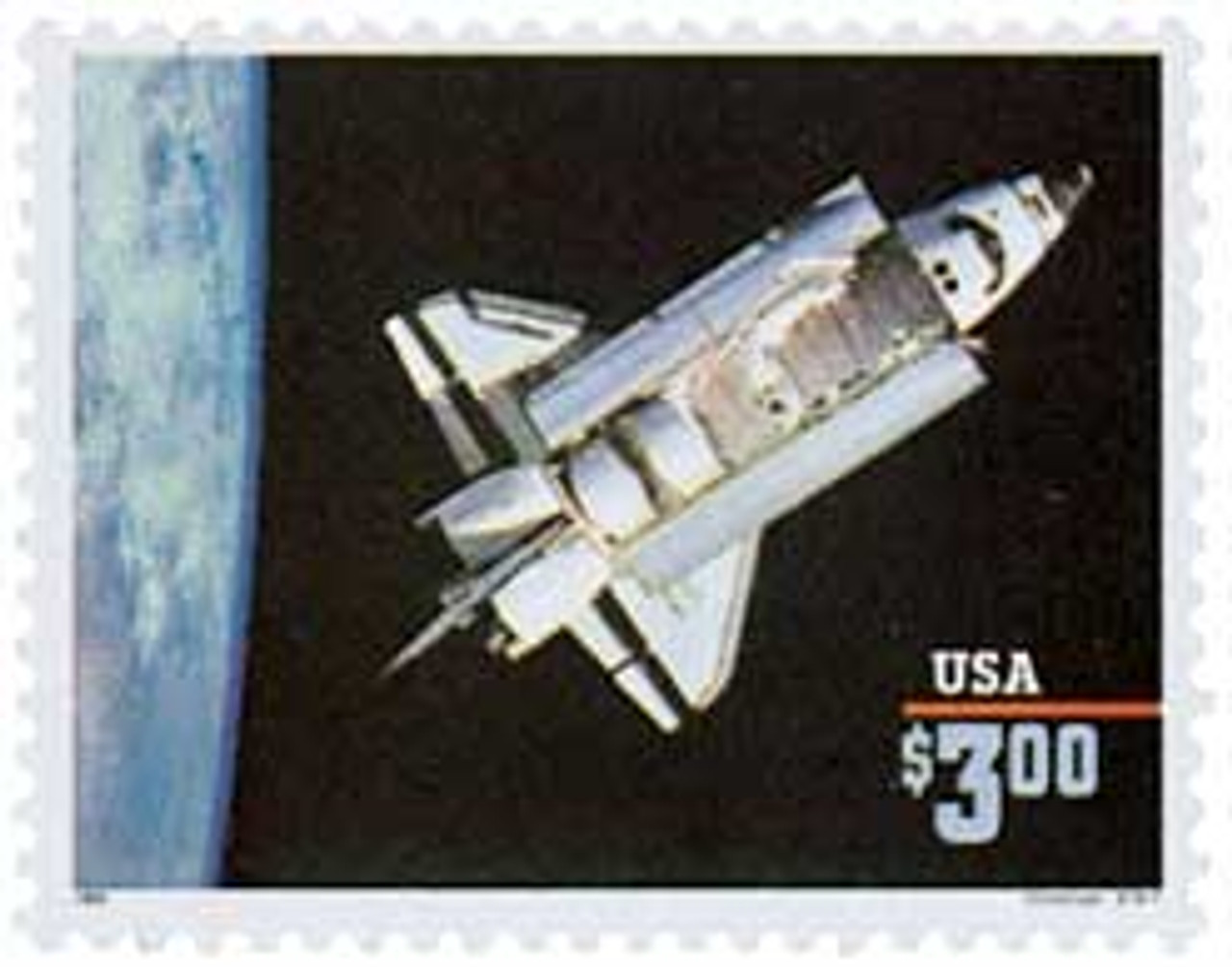
US #2544
1995 Challenger Space Shuttle
- Priority Mail stamp
- One of two semi-jumbo stamps with US space shuttle theme
Category of Stamp: Definitive
Value: $3, Priority Mail
First Day of Issue: June 22, 1995
First Day City: Anaheim, California
Quantity Issued: 100,000,000
Printed by: Ashton-Potte... more
US #2544
1995 Challenger Space Shuttle
- Priority Mail stamp
- One of two semi-jumbo stamps with US space shuttle theme
Category of Stamp: Definitive
Value: $3, Priority Mail
First Day of Issue: June 22, 1995
First Day City: Anaheim, California
Quantity Issued: 100,000,000
Printed by: Ashton-Potter (USA) Ltd.
Printing Method: Lithographed and engraved
Format: Panes of 20
Perforations: 11.2
Reason the stamp was issued: This stamp was issued to cover the postage rate for Priority Mail after that rate was increased to $3. It honors the space shuttle Challenger’s 1983 mission, STS-7. Mission specialist Sally Ride was on the crew of that flight and became the first American woman in space. Three years later, Challenger exploded moments after lift-off, a tragedy that was viewed by millions.
About the stamp design: Official photographs from the National Aeronautics and Space Administration (NASA) were used for this stamp. The Space Shuttle pictured is Challenger. The photo was taken by astronaut Bruce McCandless II while he was performing an extravehicular activity. The camera was affixed to his helmet.
Special design details: There is no obvious marks on the space shuttle identifying it as Challenger, but microprinting in the lower right corner reads “Challenger STS-7.”
First Day City: The First Day of Issue ceremony for this stamp took place at the Postage Stamp Mega-Event in Anaheim, California. This event was sponsored by the American Stamp dealers Association and the US Postal Service.
History the stamp represents:
The Space Shuttle Challenger Disaster
On January 28, 1986, the space shuttle Challenger broke apart during the launch of its 10th mission.
America's second orbiter in the Space Shuttle program (after Columbia), Challenger was named after the British ship HMS Challenger. The contract for the shuttle's construction was awarded in 1979 and was completed in 1981.
The Challenger made its first flight on April 4, 1983. After that, it flew 85% of all shuttle missions, averaging about three per year between 1983 and 1985. During this time, Challenger carried the first American woman, African American, Dutchman, and Canadian into space. It also conducted three Spacelab missions and made the first nighttime launch and landing of a space shuttle.
In 1986, Challenger was slated to carry out the 25th mission of the US Space Shuttle program. The mission was planned as the first Teacher in Space Project and would have observed Halley's Comet for six days. The crew consisted of Commander Francis R. Scobee, Pilot Michael J. Smith, Mission Specialists Ronald McNair, Ellison Onizuka, and Judith Resnik, Payload Specialists Gregory Jarvis and Christa McAuliffe, who was also would have been the first teacher in space.
Challenger was launched at 11:38 local time on January 28, 1986, in Cape Canaveral, Florida. Just 73 seconds into the flight, the spacecraft disintegrated due to a structural failure (later discovered to be a failure in the primary and secondary O-rings in the shuttle's right Solid Rocket Booster).
The disaster killed all seven crew members and destroyed the orbiter. It was the first of two US orbiters to be destroyed in flight (the other being the Columbia in 2003). Days after the accident, President Ronald Reagan attended a special ceremony honoring the crew members where he stated, "Sometimes, when we reach for the stars, we fall short. But we must pick ourselves up again and press on despite the pain."
Immediately after the accident, the shuttle program was put on hold for 32 months. President Ronald Reagan also created a special commission to investigate the accident. The commission found a number of issues that contributed to the accident. Among them were that NASA had violated its own safety rules and the failure of some managers to address warnings about the O-rings and launching in cold temperatures.
Recovery efforts began right after the accident and continued for some time. Among the items recovered was an American flag, dubbed the Challenger flag, which had been sent by Boy Scout Troop 514 of Monument, Colorado. Most of the debris from the shuttled was buried in a former missile silo.
The Challenger and its crew have been honored in a variety of ways since then. The families of the crew created the Challenger Center for Space Science Education. Seven asteroids, as well as seven craters on the Moon, were named for each of the astronauts. A painting of the crew was added to the US Capitol Brumidi Corridors. There are several Challenger schools and a Challenger Air Force Unit.












